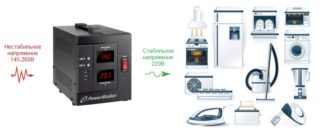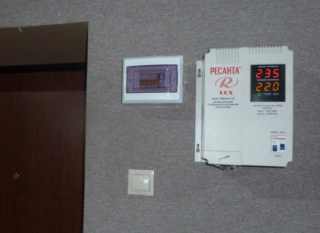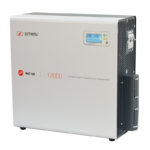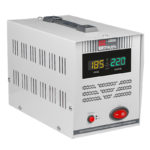The parameters of the power grid for residents of cities and megacities are usually more stable, but there is still a chance of voltage sagging. As practice shows, even minor jumps can adversely affect the performance and life of modern electronics and household appliances. To prevent adverse effects, voltage stabilizers have been invented.
When it is recommended to install a voltage stabilizer in the apartment
It is recommended to install voltage stabilizers in all cases, without exception, especially if there are a lot of expensive electrical appliances at home that are susceptible to power surges.
The requirements of the International Electrotechnical Commission state that the voltage in everyday conditions should fluctuate within 230V + - 10%. But at the same time, in many regions of Russia old standards still apply, in which the permissible range within 220 V + is 10%.
To calculate the network parameters in a particular case, it is necessary to carry out measurements for a long time at different times of the day. It is better to contact a specialist who will use equipment that automatically analyzes all the information received on it during the day.
If regular voltage subsidence is observed, you can write a complaint to the local energy supply company, referring to non-compliance with standards (GOST 29322-2014).
What technique needs voltage stabilization
 There is a category of household appliances that is immune to voltage surges, and on other devices even minor surges can affect extremely negatively. A complete failure of the equipment is possible.
There is a category of household appliances that is immune to voltage surges, and on other devices even minor surges can affect extremely negatively. A complete failure of the equipment is possible.
- Boilers equipped with electronics. Obsolete models with mechanical control are less susceptible to differences, and expensive modern models quickly fail.
- Vacuum cleaners and air conditioners. These devices are equipped with asynchronous motors, which at low voltage begin to absorb more current than expected, this leads to the fact that the motor windings are very hot.
- Dishwashers do not automatically turn off during power surges, which leads to overheating and failure of the relay, coil or the motor itself.
- Outdated models of refrigerators. Their disadvantage is the same as that of air conditioners and vacuum cleaners. At low voltage, the motor heats up and runs noisily.
Power surges adversely affect the performance of microwave ovens, old televisions, fluorescent and energy-saving lamps.
Which stabilizer to choose
There are several types of stabilizers. Outdated ferroresonance devices are no longer used, so it is not practical to consider them in detail.
- Invertor. Innovative development, which is structurally different from all existing analogues. The principle of operation is based on advanced dual energy conversion technology. Such models have no shortcomings, with the exception of high cost.
- Relay modifications are based on switching transformer windings with a special relay. Preference is given to the winding at which the voltage is closest to the nominal value. The main advantages are reasonable cost and high response speed. But there is one significant drawback - the average accuracy of stabilization, which may not be enough for sensitive modern technology.
- Thyristor and triac are similar in principle to relay stabilizers, however, switching between inductors is carried out by high-speed and highly efficient parts - triacs and thyristors. Characteristic features surpass all analogues. They are often used in domestic conditions, but they cannot ensure 100% safety of household appliances.
- Electromechanical stabilize the voltage by moving a special contact on the transformer winding. The main advantages of models of this type are low cost and high accuracy of stabilization. The main drawback makes the device practically unused in apartments - low response speed.
When choosing a voltage stabilizer, you should pay attention to the power of the device, its range of operation and accuracy.
- Thyristor
- Invertor
- Relay
- Electromechanical
Power selection
The principle of calculating power is the same for all types of stabilizers - the power of all used electrical appliances is summed up and a margin of 20% is added.
The table lists the approximate power ranges of electrical appliances, most often used in apartments.
| Electrical appliance | Power range, measured in watts |
| Slow cooker | 500-1600 |
| Cooker hood | 56-8010 |
| Music player | 50-500 |
| Electric kettle | 650-2400 |
| Toaster | 200-1500 |
| Hair dryer | 100-2500 |
| Microwave (microwave) | 600-2000 |
| Air conditioning, split system | 650-2400 |
| Coffee machine | 500-2300 |
| Iron | 250-3100 |
| Heater | 800-2500 |
| Washing and / or dishwasher | 425-3500 |
| A laptop | 20-80 |
| PC system unit | 200-400 |
| TV | 50-400 |
| Refrigerator | 150-600 |
| A vacuum cleaner | 100-2500 |
The power of some devices may vary slightly. The accompanying documentation for the instruments contains all the required information.
The choice of stabilizer for range and accuracy
 All devices indicate the operating range. This parameter is the value of the input voltage at which the stabilizer must adjust the output voltage. If the value exceeds the permissible values, the device will automatically de-energize all electrical appliances in the apartment.
All devices indicate the operating range. This parameter is the value of the input voltage at which the stabilizer must adjust the output voltage. If the value exceeds the permissible values, the device will automatically de-energize all electrical appliances in the apartment.
To calculate the operating range of a household stabilizer, it is necessary to carry out control measurements of the incoming voltage in the network for several days. It is preferable to take measurements in the morning and evening, when the load on the electric mains is as high as possible. The extreme values obtained as a result will be valid values of the operating range of the stabilizer.
By accuracy is meant the maximum difference up or down of the output parameter from the nominal value. Almost all electrical appliances operate with a stabilization accuracy of 220 V + - 5-7%.
Voltage stabilizers are recommended to be purchased by owners of apartments, country houses and cottages. This is due to the instability of the electric mains and the high susceptibility of a certain category of household appliances to power surges.







